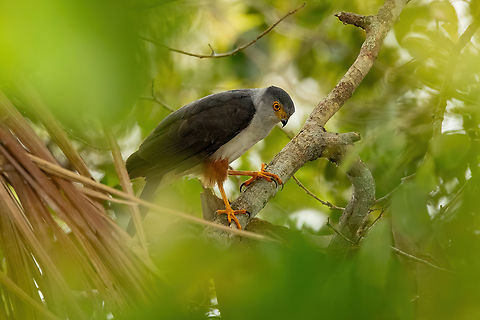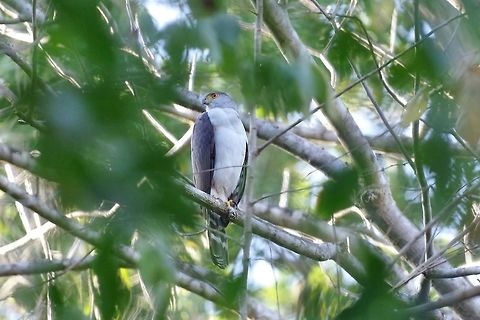
Appearance
At 34–45 centimetres in length and 200–450 grams in weight, it is significantly smaller than the northern goshawk of Eurasia and North America, and somewhat smaller than the Cooper's hawk of North America, but among the largest "Accipiter" hawks in Central and South America. As in other "Accipiter" hawks, the female is far larger than the male. Adults are grey above with darker wings and crown, and a banded tail. The underparts typically vary from dark grey to very pale grey, but the southern subspecies can sometimes be rufescent below. The thighs are always pure rufous, and the underwing coverts are white in the northern subspecies and rufous in the southern. Juveniles are very variable. They can be white, buff or rufous below, and sometimes with dark streaks. Their upperparts are browner than in adults, and the thighs are sometimes paler.
Distribution
The bicolored hawk is widespread but uncommonly observed. Its range extends from Mexico to west Ecuador, the Guianas to Colombia, south to east Peru, through Amazonian Brazil to Paraguay, north-north western Argentina, Bolivia and to Chile. It mainly resides in forests, along forest edges and in clearings in tropical and locally subtropical zones, although its habitat is none too specialized. It may also reside in rain forest, drier, thinned forest, and palm savanna with gallery forest.Forest disturbance and fragmentation negatively affect the habitat and quantity of the bicolored hawk, which is most abundant in primary undisturbed forest or riparian forest. There are fewer hawks in disturbed habitats such as forests that have been logged, and even fewer in those fragmented habitats that provide greater than 66% forest cover. These hawks are rarely present in forests that provide less than 66% forest cover.
Behavior
The bicolored hawk is difficult to detect due to its shyness and inconspicuousness. Because of this behaviour, the bicolored hawk may be more common than it seems.Habitat
The bicolored hawk is widespread but uncommonly observed. Its range extends from Mexico to west Ecuador, the Guianas to Colombia, south to east Peru, through Amazonian Brazil to Paraguay, north-north western Argentina, Bolivia and to Chile. It mainly resides in forests, along forest edges and in clearings in tropical and locally subtropical zones, although its habitat is none too specialized. It may also reside in rain forest, drier, thinned forest, and palm savanna with gallery forest.Forest disturbance and fragmentation negatively affect the habitat and quantity of the bicolored hawk, which is most abundant in primary undisturbed forest or riparian forest. There are fewer hawks in disturbed habitats such as forests that have been logged, and even fewer in those fragmented habitats that provide greater than 66% forest cover. These hawks are rarely present in forests that provide less than 66% forest cover.
Reproduction
Bicolored hawks breed in forest areas, choosing to build nests on tree branches and occasionally hanging vines. The nest is built in cooperation between the male and female and is constructed from dried sticks and leaves. Each breeding pair will normally build a new nest at the beginning of each breeding year. Copulation occurs after breeding activities such as feeding and nest building have been completed. Egg laying takes place approximately five weeks after copulation and the dull white eggs measure an average of 47.1 mm × 36.5 mm; clutches average 1–3 eggs. The eggs are brooded for about three weeks by the female while the male forages for food. Bicolored hawk chicks are categorized as semi-altricial; the eyes are open at hatching but the chicks are not immediately mobile and are fed by the parents. The young fledge around 30–36 days after hatching and the fledgling period spans nearly seven weeks, during which the young will return to the nest frequently for food until they become independent.Food
These hawks capture prey in a stealthy manner by flying through dense vegetation to ambush unsuspecting prey. They may also capture prey through aerial pursuit after inconspicuously sitting and watching their target. At times, the bicoloured hawk may hunt in pairs. Most commonly, it feeds on smaller birds such as thrushes and small doves but has also been known to consume small mammals including bats and reptiles. Several instances where the hawks attack groups of squirrel monkeys or tamarins have been witnessed. In addition, these hawks may follow groups of monkeys in order to feed on the insects that are exposed by the monkeys.References:
Some text fragments are auto parsed from Wikipedia.